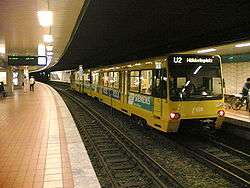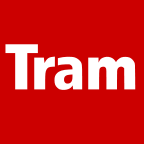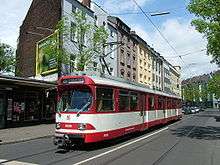Stuttgart Stadtbahn
 | |||
|
Stuttgart Rathaus Stadtbahn underground station | |||
| Overview | |||
|---|---|---|---|
| Locale | Stuttgart, Baden-Württemberg, Germany | ||
| Transit type | Light rail (Stadtbahn) | ||
| Number of lines | 15 (& 2 special event lines)[1] | ||
| Number of stations | 203 (2013)[2] | ||
| Annual ridership | 174.9 million (2014)[2] | ||
| Website | Stuttgarter Straßenbahnen AG (SSB) | ||
| Operation | |||
| Began operation | 28 September 1985[3] | ||
| Operator(s) | Stuttgarter Straßenbahnen AG | ||
| Number of vehicles | 179 (2013)[2] | ||
| Headway | 10 minutes (daytime) | ||
| Technical | |||
| System length | 130 km (81 mi) (2013)[2] | ||
| Track gauge |
1,435 mm (4 ft 8 1⁄2 in) standard gauge | ||
| Electrification | 750 V DC overhead lines | ||
| Average speed | 27 km/h (17 mph)[2] | ||
| Top speed | 80 km/h (50 mph) | ||
| |||
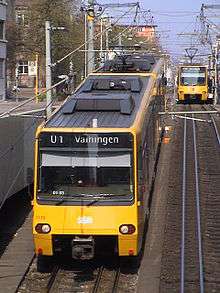

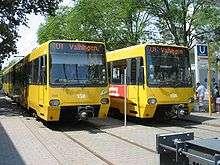
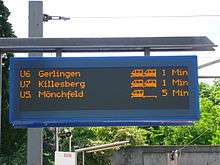
The Stuttgart Stadtbahn is a light rail system in Stuttgart, Germany. The Stadtbahn began service on 28 September 1985.[3] It is operated by the Stuttgarter Straßenbahnen AG (SSB), which also operates the bus systems in that city. The Stuttgart Stadtbahn is successor system of a tram network (Straßenbahnen) that characterized the urban traffic in Stuttgart for decades.
The network of Stuttgart Stadtbahn covers much of Stuttgart and also reaches the neighbouring towns of Remseck am Neckar, Fellbach, Ostfildern, Leinfelden-Echterdingen and Gerlingen (clockwise). Currently, the Stuttgart Stadtbahn system is made up of fifteen lines (U1-U9, U12-U15, U21 and U24) and two special event lines (U11 and U19),[1] serving 203 stations, and operating on 130 kilometres (81 mi) of route.[2] In 2014, the Stuttgart Stadtbahn carried 174.9 million passengers.[2]
Lines
As of 2016, the Stuttgart Stadtbahn system is made up of thirteen main lines (U1-U9 and U12-U15), two special lines (during the construction site between Charlottenplatz and Staatsgalerie; U21 and U24) and two special event lines (U11 & U19):[1]
| Line | Route | stations | journey time (in minutes) |
|---|---|---|---|
| U1 | Fellbach Lutherkirche – Bad Cannstatt – Hauptbahnhof – Rotebühlplatz – Marienplatz – Heslach – Vaihingen | 34 | 46 |
| U2 | Neugereut – Bad Cannstatt – Hauptbahnhof – Rotebühlplatz – Vogelsang – Botnang | 27 | 36 |
| U3 | Plieningen – Möhringen – Vaihingen | 11 | 13 |
| U4 | Untertürkheim – Ostendplatz – Neckartor | 13 | 16 |
| U5 | Killesberg – Hauptbahnhof – Charlottenplatz – Degerloch – Möhringen – Leinfelden | 22 | 29 |
| U6 | Gerlingen – Giebel – Feuerbach – Pragsattel – Hauptbahnhof – Charlottenplatz – Degerloch – Möhringen – Fasanenhof | 40 | 52 |
| U7 | Mönchfeld – Zuffenhausen – Pragsattel – Hauptbahnhof – Charlottenplatz – Ruhbank (Fernsehturm) – Heumaden – Ostfildern | 36 | 50 |
| U8 | Vaihingen – Möhringen – Degerloch – Ruhbank (Fernsehturm) – Heumaden – Ostfildern (Only Mon-Fri between 06:00 and 20:00.) |
26 | 33 |
| U9 | Hedelfingen – Raitelsberg – Hauptbahnhof – Vogelsang [– Botnang] (Service to Botnang only during the rush hour on school days.) |
22 [28] | 29 [35] |
| U12 | Hallschlag – Löwentor – Nordbahnhof – Hauptbahnhof – Charlottenplatz – Degerloch – Möhringen – Dürrlewang | 27 | 38 |
| U13 | [Giebel –] Feuerbach – Pragsattel – Löwentor – Bad Cannstatt – Untertürkheim – Hedelfingen (Service to Giebel only during the rush hour on school days.) |
23 [30] | 35 [43] |
| U14 | Remseck – Mühlhausen – Münster – Wilhelma – Hauptbahnhof – Rotebühlplatz – Marienplatz – Heslach | 33 | 47 |
| U15 | Stammheim – Zuffenhausen – Pragsattel – Hauptbahnhof – Charlottenplatz – Eugensplatz – Ruhbank (Fernsehturm) [– Heumaden] (Service to Heumaden only during the rush hour on school days.) |
27 [32] | 37 [45] |
| U21 | Charlottenplatz – Marienplatz – Südheimer Platz | 7 | 9 |
| U24 | Charlottenplatz – Rotebühlplatz – Hölderlinplatz | 8 | 9 |
| U11 | Charlottenplatz – Rotebühlplatz – Hauptbahnhof – Charlottenplatz – Cannstatter Wasen / Neckarpark (Stadion) (Only during the Volksfest, Spring Festival, sport, music or other events.) (No stop at the stations Berliner Platz (Hohe Str.) and Staatsgalerie.) |
12/13 | 17 |
| U19 | Bad Cannstatt – Neckarpark (Stadion) (Only during sport, music or other events, if the line U11 does not run.) |
2 | 3 |
History
Stuttgart Stadtbahn, now all standard gauge (1,435 mm (4 ft 8 1⁄2 in)), developed out of a traditional tramway system, which in Stuttgart was metre gauge.
In 1961 the city council of Stuttgart decided that a general modernization of the municipal tram system was needed; in central areas, the tram should be relocated underground, and in peripheral areas it should get new tracks that would be separate from road traffic. Concurrent proposals for a new completely underground subway (U-Bahn) were rejected in 1976. At the same time it was decided to enhance modernization of the existing tram in combination with a change from metre gauge to standard gauge. For this reason, Stuttgart made the intermediate effort of rebuilding almost all its tracks with mixed-gauge, on which old streetcars (SSB GT4, built 1959–1965) could run as well as new metro cars (SSB DT 8, in regular service since 1985).
Current light rail system
The Stadtbahn system runs over 257 kilometres (160 mi) of rail track,[2] and 231 kilometres (144 mi) of rail line,[2] covering 130 kilometres (81 mi) of route. (The Stuttgart rail system also encompasses a rack railway (Line 10),[4] a funicular (Line 20),[4] and a weekend heritage streetcar line (Line 21).[5]) In the city centre as well as in other densely built-up districts of the city, the Stadtbahn runs underground. The Stadtbahn uses the "U" logo like the underground systems (U-Bahnen) in other German cities. However, here the "U" does not stand for untergrund (underground) but for unabhängig (independent, meaning independent of other traffic infrastructure). Outside the densely built up areas, the Stadtbahn runs on the surface, often along roads with level crossings, though on a separate right-of-way. However, in the Stammheim district, the U15 line's trains operate with street running and share space with other traffic.[6]
Light rail vehicles
The system is operated with 179 light rail vehicles,[2] operates on standard gauge track, and is electrified at 750 volts DC. On December, 8th, 2007 the ongoing replacement of the city's tram lines was finally completed after 27 years.
Color
Since the coat of arms of Stuttgart shows a black, rampant horse on a yellow or golden field, the Stuttgart Stadtbahn (as well as all the buses and the last old trams) comes in yellow with black or dark blue window frames.
Hours of operation
The Stuttgart Stadtbahn operates from 04:00 - 01:00.
- Monday-Friday: The frequency of 10 minutes starts between 06:00 - 07:00 and ends between 20:00 - 20:30.
- Saturday: The frequency of 10 minutes starts between 09:30 - 10:30 and ends between 20:00 - 20:30.
- Sunday: The frequency of 10 minutes starts between 10:30 - 11:30 ends between 17:30 - 18:00.
- On all days: Prior that frequency exists a 30/15 minutes-interval and after this a 15 minutes-interval.
- Except the line U5 will daytime in 20 minutes- otherwise in 30 minutes-interval and the line U8 only Monday-Friday from 6:00 to 19:00 in 20 minutes-interval operated.
Most routes are served by two or more lines in the city centre, so there is a train every few minutes at most stations.[7]
Fares and ticketing
The Stadtbahn is part of the regional transport cooperative, the Transit and Tariff Association Stuttgart (VVS), which coordinates tickets and fares among all transport operators in the metropolitan area. Besides the Stadtbahn, these include the SSB's bus networks, together with the Stuttgart S-Bahn, operated by a subsidiary of Deutsche Bahn AG (DBAG), and DBAG's RegionalBahn regional train services within the VVS area.[8]
Extensions
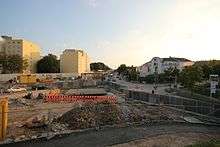
Projects under construction
U12 – Northern Extension
- Route: Hallschlag – Wagrainäcker/Aubrücke (– Remseck)
- Startup: 2017
U12 – Connection to the Europaviertel
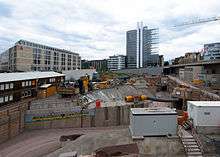
- Connecting the newly created European quarter by the station Budapester Platz, including underpass the public library
- Route: Hauptbahnhof (Main Station) – Budapester Platz – Nordbahnhof
- Startup: 2017
- Complete new routing of the line U12: Remseck – Mühlhausen - Hallschlag – Nordbahnhof – Hauptbahnhof (Main Station) – Degerloch – Möhringen – Dürrlewang
Projects in planning
U14 – Rebuilding the station Wilhelma
- Due to the construction of the Rosensteintunnel, the station will be moved to the main entrance
- Opening date: TBD
U6 – Airport link
- Link the airport and the trade fair to the network of the Stuttgart Stadtbahn, with line U6 from Fasanenhof (Schelmenwasen)
- Opening date: TBD
Possible projects
- U5 – Extension from Leinfelden to Echterdingen[9]
See also
- Stuttgarter Straßenbahnen AG
- Stuttgart Rack Railway
- Standseilbahn Stuttgart
- Transit and Tariff Association Stuttgart
References
- 1 2 3 "Stadtbahn-Liniennetz" [Stadtbahn-Network Map] (PDF) (in German). Stuttgarter Straßenbahnen AG (SSB) & VVS. September 2013. Retrieved 2013-10-05.
- 1 2 3 4 5 6 7 8 9 10 "Informationen und Fakten - Geschäftsberichte - Daten, Zahlen, Leistungen" [Information and Facts - Business Report - Data, Numbers, Performance] (in German and English). Stuttgarter Straßenbahnen AG (SSB). Retrieved 2013-10-05.
- 1 2 "Geschichte - Von 1946 bis 1990 - 1981 bis 1990" [History - From 1946 to 1990 - 1981 to 1990] (in German and English). Stuttgarter Straßenbahnen AG (SSB). Retrieved 2013-10-06.
- 1 2 "Barrierefrei Gehbehinderung oder Kinderwagen Seilbahn - Zahnradbahn" [Barrier-free - Mobility for Wheelchairs - Funicular - Rack Railway] (in German). Stuttgarter Straßenbahnen AG (SSB). Retrieved 2013-10-05.
- ↑ "SSB - Staßenbahnwelt - Oldtimerfahrten" [SSB - Streetcar world - Classic (heritage) streetcars] (in German). Stuttgarter Straßenbahnen AG (SSB). Retrieved 2013-10-05.
- ↑ Robert Schwandl. "Stuttgart Stadtbahn". UrbanRail.Net. Retrieved 2014-09-26.
- ↑ "Timetable Information". Transit and Tariff Association Stuttgart (VVS). Retrieved 2013-09-07.
- ↑ "About VVS". Transit and Tariff Association Stuttgart (VVS). Retrieved 2013-09-07.
- ↑ "Stadtbahn projects". Stuttgarter Straßenbahnen AG (SSB). Retrieved 2013-09-07.
External links
| Wikimedia Commons has media related to Trams in Stuttgart. |
- Stuttgarter Straßenbahnen AG (SSB) - official website (German)
- Stadtbahn map (pdf)
- Website of the Transit and Tariff Association Stuttgart (English)
- Stuttgart Stadtbahn (UrbanRail.Net) (English)
